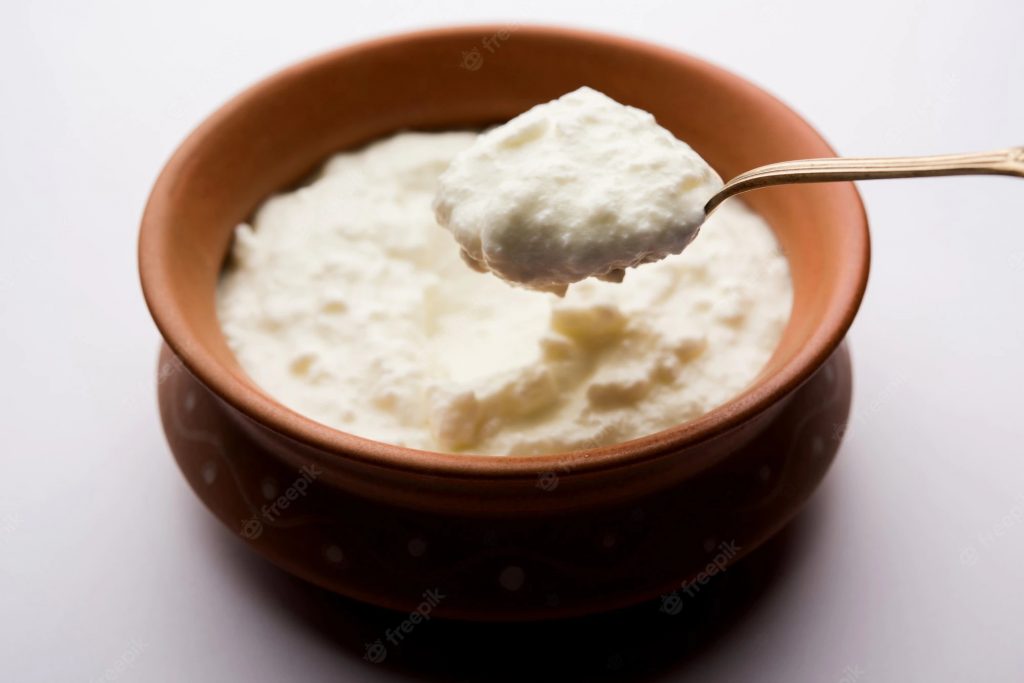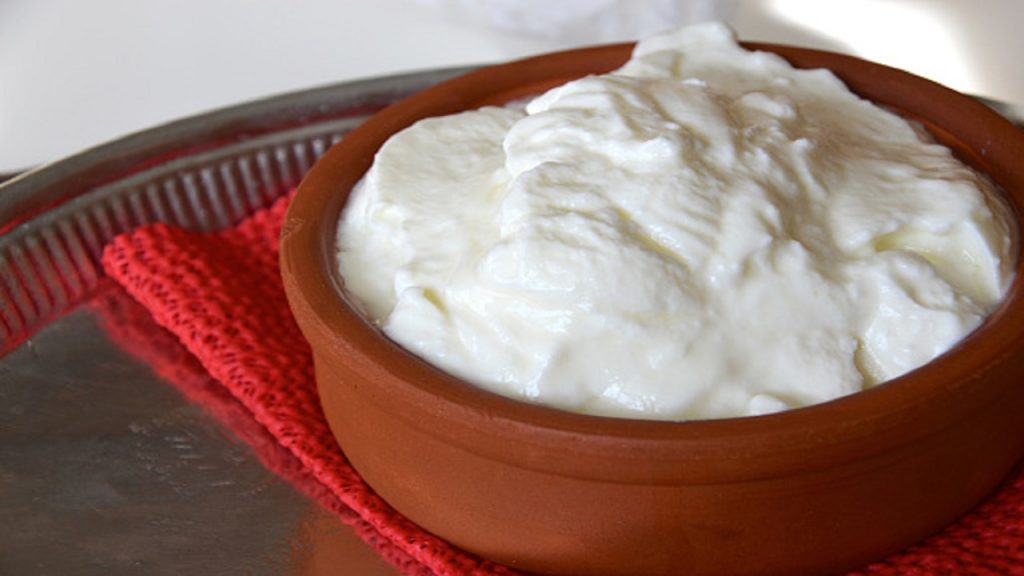This article is written for our western readers The majority of Westerners frequently confuse curd (Dahi) with yogurt. But that is not the truth. Dahi is described in the Vedas, especially in Ayurvedic scriptures, and has several advantages, both health-related and many other aspects. It is a fantastic health supplement and ought to be eaten by everyone, regardless of age, gender, or other restrictions. Read it all the way through to the finish to fully grasp how this wonder food differs from yogurt and the benefits it offers on a holistic level.

The curd (Dahi).
Dahi, also known as curd, is a milk product that has undergone fermentation. Due to the high nutritional value of curd, it has numerous advantages. Making curd, which is done every morning in almost every Indian village home, is a normal and regular task. The milk must be boiled before being cooled to between 30 and 40 degrees Celsius. Add a teaspoon of curd to the milk when it has cooled down (to lukewarm) to start the fermentation process. The bacteria grow after a few hours or if left overnight, causing the milk to curdle. Once it becomes thick, it is known as dahi or curd.
Let’s look at these in more detail and see what makes yogurt and curd different.
Difference between Curd and Yoghurt
Speaking of yoghurt and curd, they both differ in very fundamental ways. A variety of lactic acid bacteria, also known as Lactobacillus, are produced when milk is combined with curd or lemon, but yogurt is made by commercial fermentation by eating a particular strain of bacteria. Even though curd contains less lactose than milk, lactose intolerance sufferers should still avoid it because everyone’s tolerance for sugar varies.
Those who are lactose intolerant, on the other hand, should consume Greek-style yogurt. Curd is made by infusing milk with ingestible acidic ingredients like lemon or vinegar. On the other hand, yogurt is made with the yogurt culture, which is made up of Streptococcus thermophilus and Lactobacillus bulgaricus, which are bacteria that help milk ferment.
Origin and History of curd
Curd actually existed for a very long time. One of the best-known myths surrounding the origin of fermented solidified milk claims that some Turks carried milk on the backs of their camels while crossing a desert. Now, what occurred was that the bacteria in the bag and the desert sun made it possible to make curd.
Curd, also called dahi, is thought to be one of the healthiest foods because it has many health benefits. Curd never looks out of place, whether it’s summer or winter, breakfast, lunch, or dinner! Since the dawn of time, curd has held a unique place in Indian households. Eating some curd before beginning a new project or journey is seen as auspicious. Despite having only 61 calories per 100 grams, curd is a nutrient-dense food that is high in protein, vitamin D, calcium, phosphorus, vitamin E, and zinc.

Indians often eat curd, which is great for people who can’t handle lactose because it is high in calcium. The flavor of fresh curd is mild and tart. As a fermented form of milk, yoghurt has an acidic and tart flavor. It is eaten plain, marinated, or flavored with things like strawberry, vanilla, Greek yogurt, and so on. Here are the 12 wonders of curd.
1. Improves digestion
The digestive system weakens and gets slower when the temperature rises, which can cause a number of digestive problems. Curd can help you out here. Healthy bacteria are abundant in curd, which helps to maintain gut health and promote digestion. If you have gas or bloating, curd is an excellent remedy. It also aids in lowering acidity and preventing heartburn. It also makes your immune system stronger and helps you fight off a wide range of diseases, such as infections and the common cold.
Curd keeps our digestive system’s good bacteria in balance, which is very important for a healthy digestive system. Curd’s cooling properties help the spices in your food make your stomach feel better, which is very important. It starts to reduce the acidity and burning in your stomach right away. Additionally, it aids in the treatment of gastrointestinal infections, diarrhea, and constipation.
2. Promotes Weight Loss
Curd is the ideal weight-loss food if you’re attempting to shed a few summer pounds. Probiotics in curd boost metabolism and maintain a healthy digestive tract. The process of losing weight will be aided by this. It is a fantastic superfood for your weight reduction journey because it is high in proteins and low in carbohydrates. It also keeps you satisfied for a long time and helps you avoid overeating because it is very low in calories and high in protein. If you’re trying to lose weight, be sure you always include curd in your meals for a balanced and healthy diet.
3. Maintains fluid balance
The curd’s substantial water content keeps you hydrated for a very long time. The summer is demanding on your energy levels, and it is challenging to stay hydrated when you are perspiring all the time. However, curd is incredibly light and chilly, making it even more important to combat the heat and humidity when it’s sweltering outside. Additionally, eating a bowl of curd every day helps you stay hydrated and has an energy-boosting effect. Curd is renowned for having antioxidant qualities as well.
4. Strengthens Teeth and Bones
One of the best things about curd for your health is that it lowers the risk of osteoporosis, a disease that makes bones weak. The curd, though, can lessen the likelihood of it. The curd contains a lot of calcium, just like milk and other dairy products do. In addition to maintaining bone density, it also strengthens bones. It is the best natural remedy for strong bones and teeth because it is a great source of calcium, vitamin D, and phosphorus. Its consumption on a regular basis has been shown to prevent joint-related disorders.
5. Take care of your stress levels.
Even though summer is often thought of as a time for vacations and relaxation, this is not necessarily the case. Most summers are more stressful than relaxing because people have to plan picnics, trips, and work schedules. Curd can be useful in overcoming this. A bowl of curd has been shown to ease anxiety, promote relaxation, and manage stress. Recent research shows that curd makes a big difference in how your brain responds to the world around it and lowers your levels of stress and anxiety. It is a fantastic mood enhancer and helps manage lows as well.
6. Enhances Heart Health

Daily curd consumption lowers the risk of coronary heart disease because it prevents cholesterol from building up in your arteries. Additionally, curd consumption will lower blood pressure and improve cardiovascular health. Curd stops cholesterol from building up in the arteries, which lowers blood pressure and protects the heart from diseases.
Even though we usually think of milk as a source of calcium that makes bones stronger, it can also help lower the risk of heart disease and stroke. Magnesium and potassium, which are also in milk, can help lower blood pressure and improve blood flow to vital organs, which relieves stress on the heart and circulatory system.
7. Helps to maintain skin and hair health.
Your skin and hair will thank you for eating curd. Curd can be used to make cheap, all-natural skin care products that improve the texture and tone of your skin right away. To improve your appearance and achieve bright skin, rely on curd rather than other chemical-heavy beauty products.
Vitamin E, zinc, and phosphorous, three elements found in curd, all help to improve the texture and color of your skin. You may get soft, radiant skin by mixing gram flour, curd, and lemon. Curd is well-known for its anti-aging benefits and is fantastic at curing sunburns. It is a natural hair conditioner that also aids in dandruff eradication.
8. It even gets rid of dandruff.
Have you already tried and failed to remove dandruff using various hair care products? Try some curd now! Curd has anti-fungal properties because it has lactic acid in it. It can be used to treat dandruff, which is a fungal infection. Your scalp should be treated with some curd for about an hour. To get rid of dandruff, rinse it off with water.
9. Enhances Energy Levels
Your energy levels are immediately increased by the quick carbs in curd. It will prevent your energy levels from falling too low because it is high in protein and fiber. It has a lot of nutrients on its own, and it also helps the body absorb nutrients from other foods. Niacin, vitamin B3, riboflavin, and vitamin B12, which help turn food into energy, are abundant in milk. Vitamin B12 is needed to make red blood cells and for the central nervous system to work well. This provides the body with the energy it needs when it does.
10. Acts as a substitute for milk
It works well as a milk substitute; actually, a fantastic milk alternative to milk is curd. One of the numerous advantages of curd is that those who don’t want to drink milk can still benefit from it by eating it. For those who have trouble digesting milk, this is effective. In fact, it improves their mood and strengthens their digestive systems. If you’re lactose-sensitive, you can also substitute curd.
11. increases sexual health
Several studies show that eating curd may help people with sexual health problems like low libido and the inability to get or stay sexually aroused. If you want to gain weight, you should eat sugary yogurt at every meal. It actually has various advantages for sexual health and functions as an aphrodisiac.
12. increases immunity
Because it has good bacteria, curd can help your immune system and make you healthier in general. Daily consumption will also help to avoid vaginal yeast infections. Raw milk is the milk from grass-fed cows that has not been heated or mixed. It has always been criticized. But this milk offers more advantages than you might think. An investigation found that the chances of getting sick from bacteria in raw milk are three times less likely than the chances of dying in an airplane crash. Milk has things like probiotics, vitamin D, and immunoglobulins that help the immune system and make allergies less likely.
How To Obtain Curd
Some of the most well-liked summertime curd-based beverages include buttermilk, chaach, and sweetened lassi. Here are 6 intriguing and simple curd dishes to try in addition to eating it plain:

Lashi, or the Ancient Smoothie
One of the earliest smoothies ever made was possibly lassi, a truly traditional beverage. It is said to have started somewhere around 1000 B.C. One of the classic drinks in India, lassi has a creamy texture, a sweet-sour savory flavor, and is made with curd. water, and frequently sugar or salt. It is a terrifically refreshing and healthy drink.
3–4 cups plain yogurt, 6 smashed ice cubes, 1 1/2 cups ice water, 2 teaspoons white sugar, and 1 pinch salt are combined.
Blend the curd., ice, water, sugar, and salt in a blender until the mixture is frothy. In tall glasses, pour the mixture over ice cubes. For a thicker or thinner beverage, you can adjust the amount of yogurt or water added. To make a salty lassi, substitute 1/2 teaspoon salt for the sugar. If desired, garnish with fresh mint.
Customary Chaas
Almost any spice you desire can be added to cool, thick curd. along with a little water to create traditional Indian chaas. To make buttermilk, you have to churn yogurt or mix it with water and maybe some herbs or spices. While churning, some butter rises to the surface.
1.5 cups of chilled or cold curd, 1 teaspoon of roasted ground cumin, 1 tablespoon of finely chopped mint or coriander leaves, and 1/2 teaspoon of black salt should all be added to a big blender (or regular salt, as needed).
Add 12 teaspoons of freshly grated ginger, 12 teaspoons of finely chopped green chilies, or 14 teaspoons of black pepper to make masala chaas more spicy.
Misti Doi ( Meetha Dahi)
A traditional Bengali dessert called mishti doi is created using milk, curd culture, and either sugar or jaggery. Put 1 liter of full-fat milk in a large pan or kadai. Heat milk while keeping the burner at a low or medium setting. When the milk is getting warm, stir it occasionally. Bring the milk to a boil. The milk should then continue to simmer at a moderate to medium-low temperature. While the milk is simmering, stir often.
As the milk simmers continuously, it will be reduced. often stir. Additionally, add to the simmering milk the dry milk solids that were scraped from the sides. Reduce the size of the milk by 1/3 or 1/2 while it is simmering.
Let the milk cool for around 8 to 9 minutes while keeping the kadai on the table. Add the dried milk solids to the milk after removing them from the sides. Meanwhile, grate or cut 175 to 180 grammes of palm jaggery into small pieces. 34 cups of finely chopped palm jaggery are required.
Crab Dip
Put between 250 and 500 grams of curd in a sieve, hang it near the sink, and allow the water to drain out of it until the curd has reached a thick consistency. Chop one onion, one pepper, and two to three garlic cloves, then combine with the hanging curd. Use it as a dip with any snacks or sandwiches after adding salt and pepper. It tastes fantastic and is incredibly cooling.
Fruit muddles
Banana, mango, peaches, and seasonal berries should be combined in a container and pureed to make a smoothie. Blend in 1 cup of curd after adding it. Depending on your preference, you can wish to add 1/2 cup of milk or fresh orange juice.

Dahi Ke Kebab
Dry roast 1/4 cup of besan until it darkens a little, then let it cool. Add 1.5 cups of hanging curd to the mixture, along with the chopped ginger, garlic, coriander, and green chilies. Add toasted cumin, salt, and pepper to the mixture. Although it’s crucial to preserve the thick consistency, don’t overmix. Shallow-cook the ingredients after forming them into little tikkis. The best way to serve them is hot, with salad and green chutney.
The Auspicious essence of Dahi
Dahi has traditionally been a crucial ingredient in Indian cooking. People like to eat curd before important or lucky events, such as tests or job interviews. It is widely used in all Hindu rituals and has long been used in marriages and pujas. It is also talked about in the Vedas as the healthiest food and medicine that is good for the whole body. Moreover, it offers several health advantages in addition to being delicious. Curd is the best thing to eat to get your energy back, especially when it’s too hot to do anything else.
Disclaimer: This information is for educational purposes only, and no medical advice should be inferred from it. Before changing your diet or adding supplements, please talk to your doctor.
The author’s views are his or her own. The facts and opinions in the article have been taken from various articles and commentaries available in the online media and Eastside Writers does not take any responsibility or obligation for them.
Note: Contact our Writers at www.eastsidewriters.com for writing Blogs/Articles on any niche. We have experts in various domains from Technology to Finance and from Spirituality to Lifestyle and Entertainment.







Pingback: Probiotics and Prebiotics- The Secrets Of Gut Health Revealed
Pingback: Incredible Recipes To Maintain Good Health With Avocado | EastsideWriter
Pingback: Learn the 12 proven methods To Reduce Obesity without any side effects - Eastside Writers
Pingback: Avoid These Food That Spike Your Blood Sugar Considerably & Harm You
Pingback: Your Complete Guide To 15 Different Varieties Of Rice - Eastside Writers
Pingback: Diarrhea Diet That Helps Stop Loose Stool And Easy Home Treatments - Eastside Writers
Pingback: Peeling Back the Truth: The Incredible Health Benefits of Eating Bananas - Eastside Writers
Pingback: The Mighty Zinc: Exploring the Top Foods that Pack a Nutritional Punch - Eastside Writers